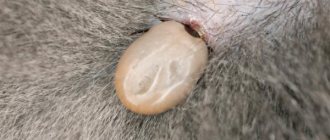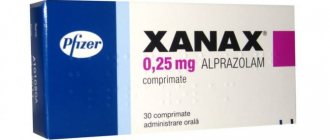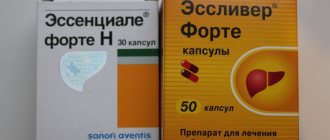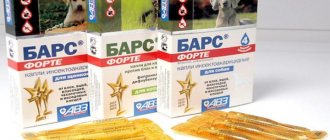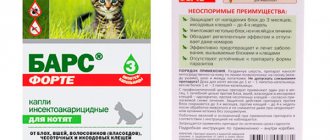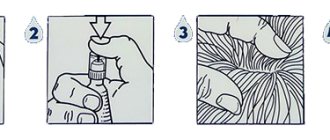Types of ectoparasites
Among the arthropod insects in Russia that parasitize cats and dogs, the most common are the following:
Dog lice
These are parasites that do not have wings and feed on blood. In dogs, Linognathus setosus is found - a yellow-gray louse, from 1.5 to 3 mm in length, with three pairs of limbs. The insect's head is elongated and noticeably narrower than the chest. The mouth structure is classified as piercing-sucking.
During their short life, lice manage to cause significant damage to a dog’s health.
The eggs (nits) are oval in shape and do not exceed 1 mm in length. They are pale yellow in color, have an operculum and are attached to the spinous hairs of the coat. The lifespan of a dog louse is within 2 months. An infected animal experiences severe itching and constantly itches, loses weight and loses hair.
lice eaters
Insects of the species Trichodectes canis and Felicola subrostratus infect dogs and cats. These are small, wingless bugs, the size of a flea, but with important differences from it. Lice-eating insects eat fragments of the epidermis and hair. They have
- a large head that is wider than the chest;
- mouthparts of the gnawing type.
Lice eater under a microscope
The presence of parasites in the fur leads to its complete or partial loss, itching and inflammation of the skin, as with scabies. The lice eater characteristic of dogs (Trichodectes canis) is dangerous because it is capable of infecting helminths, as it serves as their intermediate host, that is, as a carrier. More often, this insect “transports” the eggs and larvae of the cucumber tapeworm. The life cycle of lice eaters is from 3 to 4 weeks.
Fleas
Small and very dangerous blood-sucking insects, which, like lice and lice-eaters, lack wings. Dogs suffer from the Ctenocephalus canis variety, and cats suffer from Ctenocephalus felis.
The pairs of legs at the back of fleas are well developed, thanks to which the parasites are able to jump considerable distances. The brown body is flattened on the sides. Like lice eaters, fleas carry helminths.
Powerful hind limbs allow the flea to jump onto prey
A flea bite causes pain and unbearable itching on the animal's body. A sign of the presence of insects are numerous black “crumbs” in the back and lumbar region, which are nothing more than pest excrement. A large number of fleas can cause anemia (anemia) in the “owner”.
Life cycle of fleas
Mature creatures live up to 4 years. Their larvae and pupae can be found in trash and floor crevices. At this age, they are able to do without warm-blooded organisms, but when the insect becomes an adult and enters the blood-sucking period, it moves on to cats and dogs.
Ixodid ticks
This is another type of blood-sucking ectoparasites that carry endoporasitic larvae, which eventually enter the bloodstream of animals. The body size of icosodid mites is no more than 2 mm, but in a well-fed state they are capable of increasing 10 times! Their eggs are oval-shaped, up to 0.5 mm in length.
Ixodid ticks can be found in both animals and humans
Small parasites such as Sarcoptes, Cheyletiella, and Demodex are considered to be the cause of scabies, as well as various skin inflammations. Some live on the skin of the body, while others affect the ears from the inside.
Features of using anti-ectoparasite remedies
The preparations are in the form of emulsion solutions. To use, you need to dilute the concentrate with water (the exact ratio is indicated in the instructions), and then bathe the animal in the composition or spray it with a sprayer.
Suitable for processing dogs, pigs, horses, sheep, goats, cattle. The active ingredients destroy fleas, lice beetles, ixodid ticks, skin beetles, sarcoptic and chicken mites, flies and other pests.
LLC "Laboratory MediLIS" is a manufacturer of antiparasitic agents suitable for preventive treatment of premises. For this purpose, the spraying method is used. Before treatment, animals, birds and people must be removed from the premises. You should spray all places where parasites may be hiding: trenches for removing droppings, any flat surfaces (including the ceiling). Feeders and drinking bowls cannot be processed. Instead of a sprayer, you can use a broom or rag. Some time after using the insectoacaricide (indicated in the instructions), you need to remove the dead insects and destroy them.
How to choose and where to use antiparasitic drugs
The products presented in the assortment are designed for processing objects of various types:
- agricultural premises;
- open areas (platforms, overpasses);
- any places where animals gather (places of sale, exhibitions, sports grounds).
The components are also effective when spraying equipment and inventory.
When choosing, consider which animals and in what quantity will be processed. Some insectoacaricides are recommended for use on large animals. There are options for dogs and cats. In this case, you need to apply the solution to the fur with a sponge or swab. The period of protective action reaches 20 days. It is also allowed to spray dogs and cats with non-propellant cylinders, but make sure that the drug does not get on the mucous membranes.
Where and how does infection occur?
Ectoparasites reach animals in different ways. More often this happens during walks in nature - in the forest, city parks and squares. A special risk group consists of animals that are allowed to roam freely. They visit garbage dumps, which are full of ectoparasites and their carriers - rats, as well as stray cats and dogs. Street animals have a huge number of parasitic insects in their fur.
Pets that frequently visit the forest are at risk of becoming infected with ectoparasites.
In pets undergoing treatment, secondary infection may occur if, during the treatment of the animal, the owners did not properly treat the apartment or bedding on which the pet sleeps.
Diseases caused by ectoparasites
Table 1. Types of scabies according to their pathogen
| Pathogen | Disease | Symptoms and course of the disease |
Otodectes cynotis | Otodectosis or ear scabies | A dark brown discharge drains from the animal's ears, which dries and turns into crusts and scabs. Sick pets scratch their ears and shake their heads frequently and violently. Constant scratching leads to the formation of bald patches and wounds. Without treatment, otodectosis is complicated by problems with the eardrum, as well as inflammatory processes in the deep parts of the ear. Warm-blooded pets, including not only dogs and cats, but also rodents, are at risk for the disease. The exchange of ticks occurs when sick pets come into contact with healthy ones. |
Cheyletiella | Cheyletiellosis or wandering scabies | A parasitic disease caused by Cheyletiella mites. The main symptom of cheyletiellosis is severe flaking of the skin, resulting in dandruff appearing in the animal’s fur. It is noteworthy that the disease is not always accompanied by itching. In some cases, greasy skin, as well as various rashes, are noticeable on the affected surfaces. The back area is most often affected, but the pathology does not affect the deeper layers of the skin unless there is a secondary infection or allergy. Infection occurs through contact, with young and weakened animals being a particular risk group. The disease spreads quickly if animals are kept in crowds and in conditions of poor animal hygiene. |
| Demodex canis | Demodicosis | The disease is seasonal, since the insect is usually active during the warm period of the year - from April to September. The pathology is manifested by itching and redness of the skin. After a few days, vesicles with dark brick-colored contents form at the site of inflammation. When they burst, the exudate comes out, and the hair falls out in the affected area. This form of demodicosis is called pustular. If there are less than five areas of inflammation on the animal’s body, they speak of a localized course; if there are more, they speak of a generalized course. Animals have a hard time with demodicosis - they become less active and lose their appetite. |
Notoedres cati | Notoedrosis | The pathology first affects the scalp, then spreads to the neck and limbs. In severe cases, the entire body of the animal is covered with crusts, accompanied by areas of baldness and severe scratching. In the absence of treatment or its insufficiency, notozdroz becomes chronic, which is often accompanied by the addition of a secondary infection. The first and main symptom of the disease is itchy skin. It is caused by the fact that the mite infects the epidermis and then penetrates into the deep layers of the skin. The animal itches, and papules (vesicles) appear on the body, after opening which crusts remain |
| Linquatus setosus | Siphunculatosis or lice | The main symptom of the pathology is itchy skin. Due to constant scratching, the guard hairs break off, so the pet's coat looks disheveled. Over time, patches of alopecia (baldness) form on the skin. The body is covered with bleeding scratches from the animal's claws. The risk of secondary infection increases. The protruding blood, after drying, forms crusts, and the skin becomes rough and less elastic. The surface of the body becomes rough and shows signs of peeling. Sick animals lose weight, the growth and development rates of young animals decrease |
This is not a complete list of diseases of domestic animals that are caused by ectoparasites. Moreover, scabies is not always a sign of ectoparasites. You can find out about other reasons why your dog itches on our portal.
To restore health to your pet, it is important to determine the type of pathogen so that the treatment is adequate and complete.
Video - Treatment of ectoparasites in cats and dogs
Preparations against ectoparasites and rules for their use.
Products against fleas, ticks and other ectoparasites are divided into:
- Drops on the withers - destroy parasites and protect the animal from them for 3-4 weeks, easy to use, no discomfort for the animal. Disadvantages - 3 days before treatment and for 3 days after it is not advisable to bathe the animal; the effect occurs only after 24 hours. The dosage depends on the weight, for example, for animals weighing up to 4 kg, from 4 to 8, and so on. You need to apply the contents of the entire pipette. For example, if a dog weighs 5 kg, and the dosage of the drug is from 4 to 8 kg, then there is no need to divide it, the contents of the pipette are used entirely. The drug is applied strictly to the skin between the shoulder blades and higher to the head, after spreading the hair.
- Shampoos - the advantages include being cheap, fast acting, dirt and parasite excrement are washed off from the skin and fur. Disadvantages - they provide short-term protection; for many animals, bathing is stressful. Directions for use: wet the animal’s fur, apply shampoo, avoiding contact with eyes, leave for 10 minutes and rinse with warm water.
- Sprays - begin to act immediately after treatment, provide about a week of protection against parasites. Disadvantages - inconvenient processing, to maintain the dosage you need to count the presses of the dispenser, short duration of protection, the drug is washed off by rain and when swimming. Treatment method: apply the product evenly to the animal’s skin, first parting the fur of long-haired breeds.
- Collars - the advantages include the duration of action and ease of use. Disadvantages - many collars have an unpleasant odor, discomfort for the animal, constant wearing is necessary, irritation may occur at the site of contact with the skin, active dogs often lose collars while running through bushes or while playing. Rules of use - the collar must be worn tightly, with no more than 2 fingers between it and the skin. Before putting on the collar, it is advisable to activate it - slightly pull the ends to improve the release of the active substance.
- Tablets are a recently introduced form of flea and tick medication, but are already widely used. Pros: ease of use, the product acts within a few hours after administration, practically does not cause allergies, the animal can be bathed regardless of the use of the drug, long-lasting protection. The tablet can be given regardless of meals.
For everyday protection of cats from fleas and ticks, a popular scheme is: treatment with flea drops, after 3-4 weeks a collar is put on, after its expiration date, drops are treated again, and so on. Shampoos are used in cases of severe parasite infestation, when it is necessary to simultaneously destroy them and cleanse the animal’s skin.
For dogs in winter, the same scheme is suitable, and during the period when ticks are active, it is recommended to combine 2 means of protection, for example, drops and a collar or a collar and spray. This will create cross-protection and protect the dog from being damaged by ticks if the effectiveness of one of the products decreases for any reason.
What happens if you don't treat the animal?
Most likely, it will die, but before that it will infect the maximum number of living creatures around. The presence of ectoparasites on the body of cats and dogs significantly worsens their health, since:
- the nervous system of pets suffers - due to constant itching, sleep is disturbed and appetite disappears;
- immunity decreases, increasing the body's susceptibility to infections;
- there is a danger of infection with endoparasites, since ticks, lice and fleas are their carriers;
Infection with ectoparasites exposes the animal’s body to the risk of infection by endoparasites.
- blood-sucking insects lead to anemia of the “owner”, which negatively affects the general tone and further viability of the animal;
- the risk of allergic reactions increases;
Long-term proximity of an animal to ectoparasites leads to chronic allergies
- there is a danger of developing complications in the form of other parasitic, as well as viral and bacterial pathologies.
In addition, insects will actively reproduce, populating the area where the sick animal lives. This will become a threat to other pets as well as people.
Protective equipment for cats and dogs
Prevention of ectoparasites should begin with proper animal hygiene - maintaining cleanliness and periodically treating the animal, its habitat, bowls and toys with products that destroy pests.
The potential danger of lice, fleas and ticks is a reason to take care to protect your pets. Veterinary pharmacies and pet stores sell different types of products for the prevention of fleas and lice:
Shampoos
They should hardly be considered full-fledged means of prevention, however, by bathing the animal at the first signs of infection, you can rid it of insects and reduce the risk of endoparasitic infection to zero.
Shampoo will help cope with the first signs of infection, but will not help in advanced cases
Products for washing cats and dogs contain substances that expel lice and fleas, but, unfortunately, do not act on eggs, so the infected animal will need to be bathed every 2 weeks. To prevent your pet from picking up fleas again after washing, it is recommended to additionally treat it with other means of protection.
Collars
They provide excellent protection against insects, as they last from 3 to 7 months. That is, having put on a collar in the spring, you can leave it on until the fall and not worry about fleas and ticks. Important:
- choose a product that is suitable in size for the animal so that the animal is comfortable;
- don’t put it on tightly, but not very loosely either (the best option is when 2 fingers fit between the collar and the neck). This will ensure friction against the wool, which means the insectoacaricidal composition of the impregnation will be released in the required volume.
The collar is an excellent solution for short-haired breeds, but has its drawbacks
The collar will not protect pets whose fur requires frequent washing from ectoparasitosis. This is due to the fact that it is not recommended to remove it, since the effect of repellents begins only 1-2 weeks after the collar has been put on.
Drops for application to the withers (spot on)
They are used to treat dry, and what is important, intact skin of the pet, in the area between the shoulder blades and along the line of the spine. Such drops protect against parasites for one to one and a half months. It is necessary to ensure that cats and dogs do not lick each other until the drug has dried on the body. The spot on product, once applied to the epidermis, gradually penetrates deep into the skin, so the animal can be bathed no earlier than two days after treatment.
Drops on the withers are not immediately absorbed, so the animal must remain dry for some time.
Vet pharmacies sell both Russian (Dana, Bars, Delix, etc.) and imported (Advantix, Stronghold, Frontline) drugs. There are also compounds that protect animals from both ectoparasites and worms. These are Advokat, Bars spot-on, Prazitsid-complex and others.
Insectoacaricidal sprays
They should be sprayed onto the skin, as well as along the entire length of the coat. To ensure that the composition is evenly distributed, it is recommended to comb the animals before treatment. You can’t spray it on the muzzle area, so rub the mixture in with your hands. Applying the spray will take a lot of time, especially if it concerns a large and shaggy dog.
The spray should be distributed not only over the surface of the fur, but also over the skin of the animal
There are such products on sale as Bars, Delix, Frontline, Bolfo and others. They can also be used to treat the rug (cat house) where the animal sleeps.
Preparations in the form of solutions
These are medications (Butox, Neostomazan) that contain an insectoacaricide in concentrated form. They are sold in ampoules, after opening which the drug is diluted in water, and the resulting solution is treated with the pet or used while bathing it.
There are entire lines of tablets against ticks
Such products are economical and easy to use, but, like zoo shampoos, they are not a guarantee of long-term prevention, so they will have to be used regularly. There are also preparations available in tablet form; they are non-toxic and can be easily taken orally by the pet due to the meat flavoring.
New means for protection against ectoparasites
Looking at the availability of foreign antiparasitic agents on the Russian market today, one can note their small selection. But the most important thing: insufficient, superficial description, sometimes incorrect translation of instructions for their use is one of the reasons for our doubts about their effectiveness.
How to give first aid to your dog? What should be done first in case of poisoning, seizures, heat stroke or bites?
Fleas and ticks are the main scourge of our pets. And if the bites of the former are not fatal, then the latter can cause infection (including encephalitis), which can be fatal.
Correctly diagnosing a pet's disease is sometimes difficult. But you, as a caring owner, should know two main rules:
1. inspect your pet for ticks after every walk (comb it out if necessary); if found, remove it using a special device (read how to do this correctly here);
2. If the temperature rises sharply to 41-42 degrees (the norm is 38.5 degrees), immediately take your pet to the doctor. The temperature may drop sharply in the future, and the disease may progress. You may miss time! Tests for piroplasmosis are inexpensive and done very quickly. Only a doctor can make the appropriate treatment decision. Symptoms of piroplasmosis vary, but the most common are the following: apathy, drowsiness, refusal to eat.
Now about the second type of ectoparasites - fleas!
The main issues of infection with them, its consequences and how to deal with it, read here.
Finding a unique, super remedy for both at the same time is almost impossible! Therefore, it is better to combine them.
Understand one thing: sometimes imported protective equipment is good for pets living in the West, solely because, for example, catching a tick after a walk in a city park is nonsense. Unfortunately, this is still a fairly common occurrence in our country. There are two types of remedies: natural and chemical-based. The latter are naturally more effective, but at the same time they can cause an acute allergic reaction. And when you often write in reviews, “this collar doesn’t help against ticks, and I just threw away my money for it,” you should understand that you “threw away your money,” perhaps for citronella or margosa, which are effective in protecting against fleas or mosquitoes, but absolutely useless against, we emphasize, the Russian tick.
A natural and effective line of antiparasitic products is Beaphar Veto pure / Beaphar Veto shield.
UniZoo recommends paying attention to the innovative line of protection products against ectoparasites Beaphar Vermicon Line-on (you can find Dimethicare Line-on or IMMO Shield Line-on).
The products are available in the form of drops, shampoo
and
spray
. The latter is useful not only for owners of cats and dogs, but also for rodents.
About tick prevention
No matter what the pet is treated with, after a walk on the summer grass, it can come home with “passengers”. The very fact that a parasite gets on the fur does not mean that the dog is infected until the insect has burrowed into the skin.
The use of antiparasitic drugs does not eliminate the need for daily checks of your pet's fur.
To prevent this from happening, insectoacaricidal compounds are used. If they repel lice and fleas from a distance, then ticks - after contact with the body. Thanks to the aromatic preparation, the parasite finds the skin foul-smelling and unappetizing, so it does not bite the animal. This does not mean that ticks should not be removed from the fur. Every time after returning from a walk, the animal should be inspected and parasites removed.
Remember that some anti-tick products are toxic and require careful handling
Before purchasing a prophylactic product, you should carefully read the instructions for the drug, since:
- some are intended exclusively for cats or dogs, but there are also universal ones;
- the compositions may have side effects that you need to be aware of, and also have contraindications for use;
- treatment of animals with insectoacaricides must be carried out in compliance with safety measures, as they are toxic.
Please note that not all products are suitable for puppies (kittens), pregnant, sick and weakened animals.

